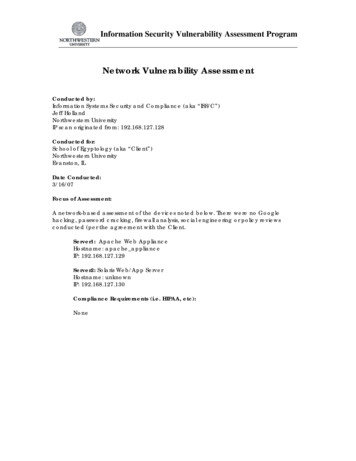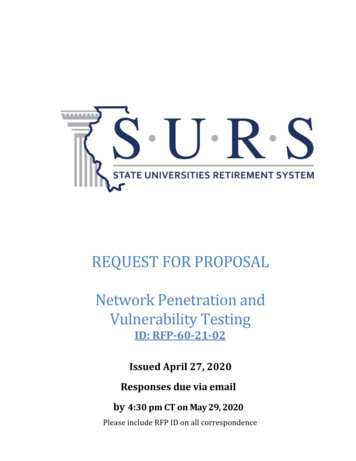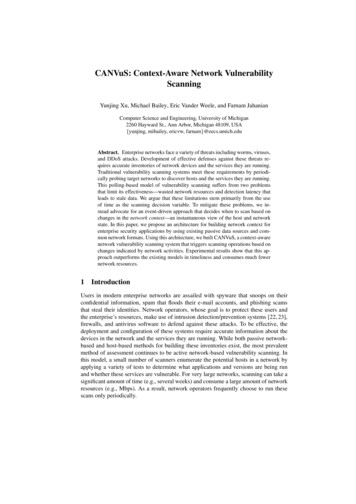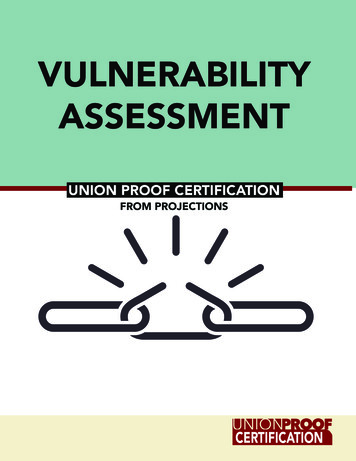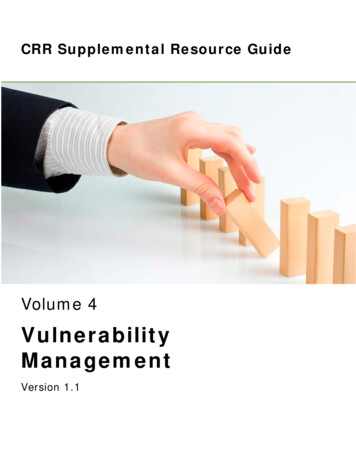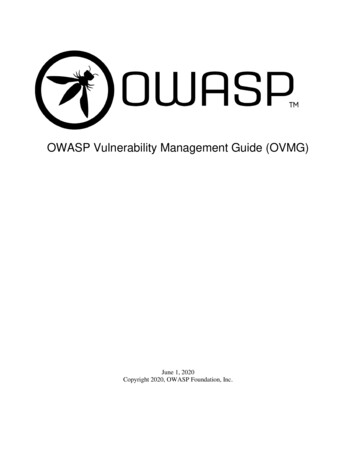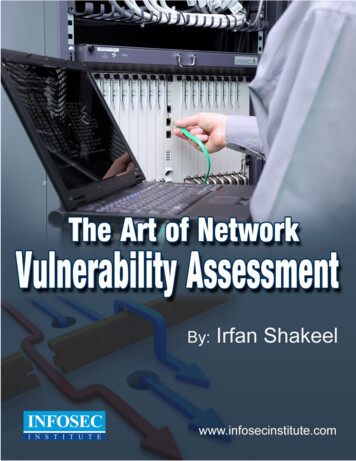
Transcription
ContentsModule 1: Introduction to Vulnerability Assessment . 3What is Vulnerability Assessment? . 3Why we need Vulnerability Assessment? . 3Types of Vulnerability Assessment . 4Network-based Vulnerability Assessment . 4Host-based Vulnerability assessment . 4The Approach to Vulnerability Assessment (Automated test and Manual) . 5The Vulnerability Assessment Process. 5Determine the Target Systems . 6Locating the live systems . 6Listing Services (one-by-one) . 6Recognizing services . 7Identification of Applications . 7Identification of Vulnerabilities in network . 7Reporting the vulnerabilities discovered . 7Vulnerability Assessment VS Penetration testing . 7Module 2: Nessus, its Configuration & Vulnerability Assessment . 8Introduction: . 8The Most Widely Deployed Vulnerability Assessment & Management Solution . 8Nessus Architecture: . 8Nessus Editions . 9Installing Nessus:. 9USER ACCOUNTS: . 11COMMUNICATION: . 13ADVANCE SETTINGS . 14SCANNING THE ENVIRONMENT . 15CREATING YOUR FIRST POLICY : . 16CREATING YOUR OWN POLICY: . 18Discovery: . 18Port Scanning . 20Service Discovery: . 211http://www.infosecinstitute.com/courses/ethical hacking training.html
ADVANCED . 21ASSESSMENT . 22SCAN RESULT ANALYSIS: . 24Web Application Scan Policy . 27Importing the Result in Metasploit . 30End Note: . 322http://www.infosecinstitute.com/courses/ethical hacking training.html
Module 1: Introduction to Vulnerability AssessmentIn this modern era, the need to analyze and eliminate vulnerabilities in your networks has become themost important task for any security expert and network administrator. We all know that today the onlyway to protect your organization's network from any possible attack is by locating and fixing the securityholes in the network. Even if an organization has a well-managed firewall, an updated antivirus, andintrusion detection system, an attacker can still get the unauthorized access by exploiting thevulnerabilities.Historically, we have seen many organizations that fell victim to a hacking attack thought that they couldnever be a target of cyber criminals. Often, we have seen small organizations that didn't take theirnetwork security seriously because of a genuine misperception that only large organizations are thetarget of cyber criminals. However, in the past, we have found many small companies fell victim to thedifferent types of attacks because they did not focus on network security. What we realized with time isthat the motive of an attacker is not always his profit. An attacker can be an unhappy customer,dissatisfied employee, or even a disgruntled contractor. Any of these individuals can target anorganization for just the sake of self-satisfaction and revenge.The objective of this eBook is not just to discuss vulnerability assessment and its process, but topractically show you an effective way of conducting vulnerability assessment test for any networkenvironment. At the end of this chapter you will learn why vulnerability assessment testing should beconducted continuously on your network, and what tools you should be using to run these testssuccessfully. Selecting the right tool is one of the most important steps of vulnerability assessmentbecause it will have an enormous impact on security of your organization's network.What is Vulnerability Assessment?“Vulnerability Assessment” or “Vulnerability Analysis” is the process of identifying and classifyingsecurity holes in an organization's system, network, or its communication infrastructure. The biggestadvantage of a vulnerability assessment test is that it can predict the success of proposedcountermeasures and examine the actual success rate after it was put into use.To put it simply, suppose a network infrastructure has been set up in an organization, all the routers,access points, computers, printers and other electronic devices have been configured and attached withthe network. Is this network secure from hacking attack? The answer is no. Now the vulnerabilityassessment comes, where an expert actually performs the test to find the vulnerabilities exist in thesystem and network.Why we need Vulnerability Assessment?Vulnerability assessment process analysis broad range of network issues, and then pinpoints theweakness in the network that needs to be fixed. This process also identifies vulnerabilities likemisconfiguration and policy noncompliance. A network administrator can get a complete picture of allhis systems and devices (connected through Wi-Fi) connected with the specific thical hacking training.html
Recently a research was conducted by “Computer Security Institute” which shows 90% of its respondingorganizations had experienced a security breach in last 12 months. 8% of these organizations havesuffered in heavy financial losses in aftermath of these breaches. Many of these organizations didn’thave a certified security professional; neither they hired any outsider to check the security of theirnetwork. Their network and systems were extremely vulnerable; this could be the main reason behindthe success of the attacks.Another advantage of a vulnerability assessment is that it will always keep you one step ahead of theattackers. It is the most powerful proactive process of securing an organization's security. SinceVulnerability assessment already identifies all the security holes an attacker can exploit, a networkadministrator just needed to patch them. All he needs to do is to keep running this test from time totime, just to keep track of new vulnerabilities.Types of Vulnerability AssessmentVulnerability assessment can be divided into two major parts:1. Network-based assessment2. Host-based assessmentThe network-based vulnerability assessment tools allow a network administrator to identify andeliminate his organization's network based security vulnerabilities. On the other hand, host-basedscanning tools help the network administrator to secure his organization's internal systems by providingan extra layer of security. Providing limited access to the hosts it prevents him from accessingconfidential data of the organization. In a nutshell, network-based analysis is to test and keep an eye onthe entire network, while host-based analysis is to keep an eye on specific hosts.Network-based Vulnerability AssessmentWhen you compare the two types of vulnerability assessment, network-based come on top because ofits ability to identify vulnerable systems on a network. A network administrator should adopt thisprocess first, while conducting the vulnerability assessment tests. A network-based test provides theimmediate results of highly severe vulnerabilities that needed a quick fix. A firewall not configuredcorrectly or vulnerable web server, which is considered very severe vulnerabilities, can be detectedeasily by running a network vulnerability test.Some common tools are:1. Nessus2. OpenVASHost-based Vulnerability AssessmentThe host based vulnerability assessment works on client-server model where client performs the scanand sends the report back to the server/manager. In this situation, client files should be installed onevery machine that you want to check. The main advantage of host-based vulnerability assessment is tokeep an eye on a suspect. Let's say, you want to monitor the activities of an employee in the /ethical hacking training.html
the suspect might create problems and might introduce vulnerabilities and malware in the network, sogo ahead and use host-based vulnerability assessment.The host vulnerability assessment enables a network administrator to eliminate the security risks frominside his organizations. This vulnerability assessment tool runs the tests from the perspective of a userwho is assigned, a local account on his system. Once a user connects with the local network, even fromguest account, he can exploit the security holes in the local servers and could end up taking control oforganization's local systems. The most common tools are: Enterprise Configuration ManagerSymantec Enterprise Security ManagerThe host-based vulnerability assessment enables a network administrator to evaluate security risksinside his organization's network. These security risks can be caused by his malicious users, ignorantusers (who don't follow the security protocols) and also users in between them.The Approach to Vulnerability Assessment (Automated test and Manual)The result of vulnerability assessment highly depends on the selected approach; there are numeroustools, both open-source and commercial are available that can make an individual confuse. But, beforeselecting the tools you should finalize your approach. How you will conduct the test, the automated testor manual? Both approaches have their own merits and demerits, and the combination of bothapproaches can take your test to the next level.The manual check-list based approach needs an intensive review or analysis of the codes, firewall rules,network policies and every aspect of the network security. Having such an approach is costly nowadaysbecause it requires an independent assessment of vulnerabilities in your systems. It may also requireorganization to hire a designated security analyst from outside, an approach which can be timeconsuming. But this is where an Automated Vulnerability assessment test comes to an organizationsrescue; it's pretty cost effective when you make a comparison with hiring security analysts from outside.Automated test signals out the highly severe vulnerabilities in the organization's networks or systems.But sometimes it fails to identify the vulnerabilities which are not highly severe in nature, and it alsogives false positive and false negative response too. This is why manual approach is there. Although
The host vulnerability assessment enables a network administrator to eliminate the security risks from inside his organizations. This vulnerability assessment tool runs the tests from the perspective of a user who is assigned, a local account on his system. Once a File Size: 1MBPage Count: 33
